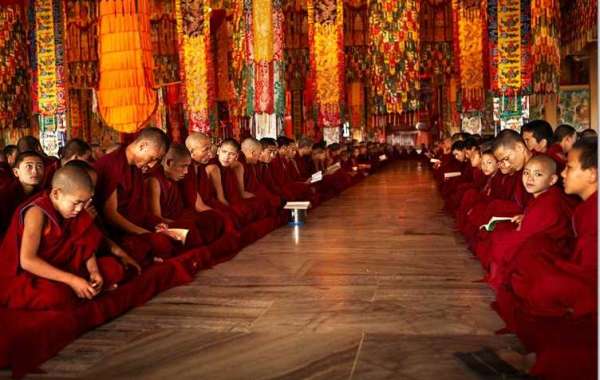Tibet is a holy land of Buddhism that attracted hundreds of tourists to travel to explore its profound Buddhist culture. In the past, the ratio was that 1 in 6 Tibetan men were Buddhist monks. Do you wanna know about the life-like of the mysterious Tibetan monks or have you ever imagined the inside picture of Buddhist monasteries?
By all means, They are dedicated to prayer and serving others and they will feel content and pleasure. Tibetan monks would never pursue the material comforts; monk food is simple, involving some Tibetan bread, vegetables, and loads of Tibetan tea. The Tibetan monks get along well with each other. Usually, they joke with each other and talk with each other.
Monk in the Tibetan language is "trapa," which means “student” or “scholar." There are three kinds of Tibetan monks residents in the monastery, including monks, scholars, and lamas. Lamas are considered the spiritual guides and master teachers who meditation techniques to disciples. In Tibetan Buddhism, they are regarded as "living gods" who possess supernatural powers that can slay demons and bring good fortune, wealth, and good health. It is absolutely that Tibetan monks play a significant role in the lives of the Tibetan people. They not only conduct religious ceremonies but also take care of the monasteries.
The Scholastic Life of Tibetan Monks
Small monks start their scholastic life in the monastery where they will learn all the monastic disciplines, and customs in monasteries and learn how to spell Tibetan Buddhist mantras and recite some basic prayers. And they need to serve their mentor or master for 3 years. Besides, they are going to take care of the chores of the monastery. Later, they will begin to start the 5 Buddhist classics, including Buddhist Logics, Heart Sutra, Madhyamika, Monastic Discipline, and Kusha-shū.
Each monk is given two commandments, the Sami at the age of 10 and the bhikkhu at the age of 20. Under the auspices of the high monk living Buddha, the ordained person makes a solemn oath in front of the sutras and buddhas to abide by the precepts and practice for the sentient beings.
Their Beliefs
Tibetan monks practice Tibetan Buddhism, which is the most widely practiced religion in Tibet. It is rooted in Mahayana Buddhism and has been practiced throughout Tibet for more than a thousand years. Throughout the millennium, Tibetan Buddhism has evolved into a unique and vibrant type of Buddhism. It has also developed a unique body of teachings and philosophies.
This body of teachings and philosophies is rich and voluminous. Yet, Tibetan Buddhism beliefs can be condensed into five essential doctrines, namely: The Four Noble Truths, The Noble Eightfold Path, the doctrines on Karma and Reincarnation, and the practice of Meditation. In this article, each of these beliefs will be briefly discussed.
What do they eat
In recent years, with the improvement of transportation in Tibet, it's become more and more convenient to be vegetarian. The Tibetan eminent monks were very pleased to see that many Han people even Westerners have a vegetarian tradition, so they began to vigorously promote Tibetan Buddhists to be vegetarian. In this case, many Tibetan monks no longer eat meat. This is a good direction because being vegetarian can reduce the suffering of sentient beings and reduce the chances of sentient beings causing evil karma. Now, all the food served in the scripture halls of the top three monasteries(Ganden, Drepung, and Sera) are vegetarian, and all the people attending the Kalachakra empowerment puja also should have vegetarian.
The diet of the Gelug Sect is not invariable. In major Buddhist events and religious ceremonies, the combination of diet is very distinctive. Let's take the Qinghai Kumbum Monastery as an example. When an abbot inaugurates, there is usually a large banquet, and the seats are basically arranged according to the height of the monk's position and rank. In front of them, there are small square tables and small strip tables with tea and fruit delicacies, such as round fried dough, pancake, rock candy, sugars, raisins, walnuts, apples, pears, and so on.
The Daily Life of Tibetan Monks
Lamas are students living in Tibetan areas. Through the accumulation of knowledge and faith, complete the "pilgrimage road" in life.
The life of the lama begins early in the morning. The lamas, led by their leaders, say morning prayers in the hall. The morning prayer lasts about 2-3 hours, during which, for three times, hundreds of young monks line up to pour butter tea and "tuba" porridge in the prayer hall. The monks eat and drink while chanting sutras, which is very interesting. After the morning praying, breakfast finishes. The next prayer is about 9 to 10 o 'clock, the lamas return to Zhacangs Hall to chant sutras and drink tea; At 3 or 4 o 'clock in the afternoon, each lama gathers in their Khangtsen (dorm) to chant sutras and drink tea.
In addition to the three prayer sessions, there are also three debate sessions per day.
In Tibetan monasteries, it is common for Tibetans to provide tea and porridge to monks. And in return, the monks chant the scripture for them. Monks would pray for happiness for a family or pray for the rest and peace for a deceased family member. After the chanting, the related family would offer some money to the monks as a particular way of giving.
Tibetan Monks live the same life. They read Buddhism scriptures, turn prayer wheels, Kowtow day after day, year after year to practice their extremely devote beliefs.
Most Tibetan monks live in 10 famous temples and monasteries such as the Jokhang Temple, Drepung Monastery, Sera Monastery, Tashilunpo Monastery, etc.








